Swinburne University Psy10004: Lab Report, Learning Techniques
VerifiedAdded on 2022/08/18
|13
|2773
|29
Report
AI Summary
This lab report, conducted by psychology students from Swinburne University of Technology, investigates the effects of massed versus distributed practice learning techniques on test performance. The study involved 240 participants who were tested on their recall using fill-in-the-blank and multiple-choice questions after using either massed or distributed study methods. The results supported the hypothesis that distributed practice is more effective for fill-in-the-blank tests and that multiple-choice test scores were not significantly impacted by either practice method. The report also discusses the methodology, including participant demographics, materials used (Bernstein et al., 2017), and the procedures followed during the experiment. The findings are compared to previous research by Rohrer & Taylor (2006) and Stanger-Hall (2012), and Goossens et al. (2016), with an aim to further understand the most effective methods for learning and information retention, particularly in the context of psychology courses. The study aimed to determine how different studying techniques influence test performance.
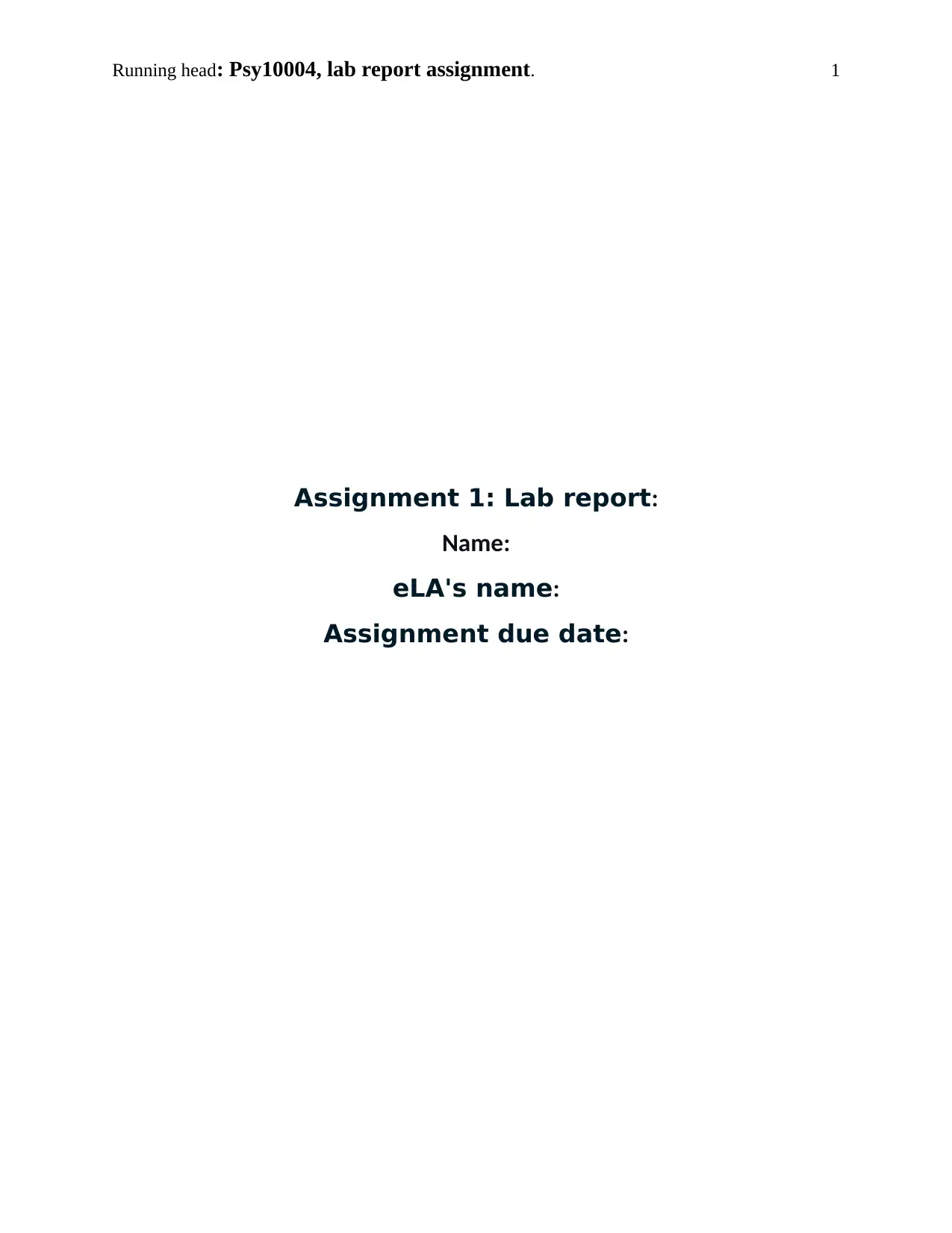
Running head: Psy10004, lab report assignment. 1
Assignment 1: Lab report:
Name:
eLA's name:
Assignment due date:
Assignment 1: Lab report:
Name:
eLA's name:
Assignment due date:
Paraphrase This Document
Need a fresh take? Get an instant paraphrase of this document with our AI Paraphraser
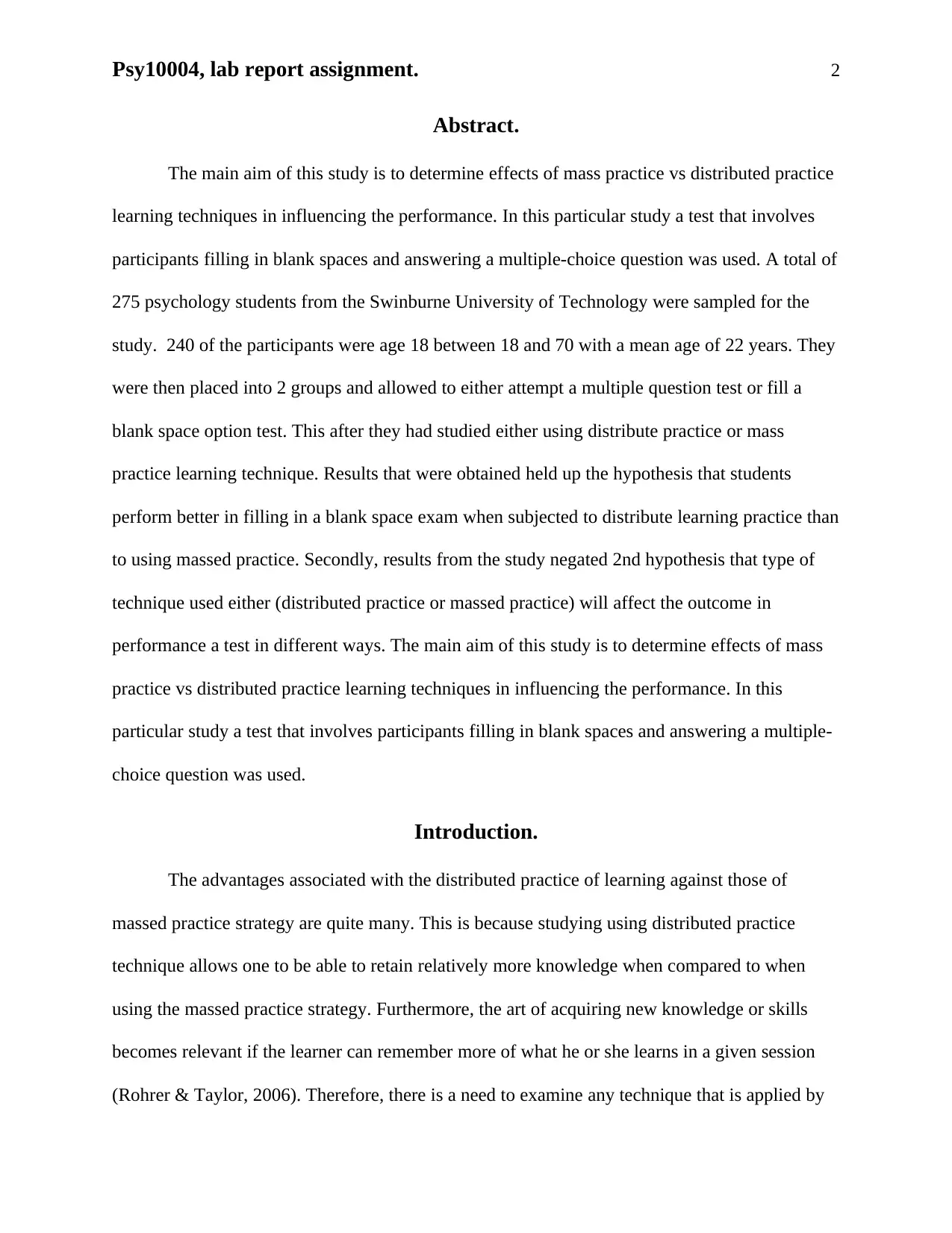
Psy10004, lab report assignment. 2
Abstract.
The main aim of this study is to determine effects of mass practice vs distributed practice
learning techniques in influencing the performance. In this particular study a test that involves
participants filling in blank spaces and answering a multiple-choice question was used. A total of
275 psychology students from the Swinburne University of Technology were sampled for the
study. 240 of the participants were age 18 between 18 and 70 with a mean age of 22 years. They
were then placed into 2 groups and allowed to either attempt a multiple question test or fill a
blank space option test. This after they had studied either using distribute practice or mass
practice learning technique. Results that were obtained held up the hypothesis that students
perform better in filling in a blank space exam when subjected to distribute learning practice than
to using massed practice. Secondly, results from the study negated 2nd hypothesis that type of
technique used either (distributed practice or massed practice) will affect the outcome in
performance a test in different ways. The main aim of this study is to determine effects of mass
practice vs distributed practice learning techniques in influencing the performance. In this
particular study a test that involves participants filling in blank spaces and answering a multiple-
choice question was used.
Introduction.
The advantages associated with the distributed practice of learning against those of
massed practice strategy are quite many. This is because studying using distributed practice
technique allows one to be able to retain relatively more knowledge when compared to when
using the massed practice strategy. Furthermore, the art of acquiring new knowledge or skills
becomes relevant if the learner can remember more of what he or she learns in a given session
(Rohrer & Taylor, 2006). Therefore, there is a need to examine any technique that is applied by
Abstract.
The main aim of this study is to determine effects of mass practice vs distributed practice
learning techniques in influencing the performance. In this particular study a test that involves
participants filling in blank spaces and answering a multiple-choice question was used. A total of
275 psychology students from the Swinburne University of Technology were sampled for the
study. 240 of the participants were age 18 between 18 and 70 with a mean age of 22 years. They
were then placed into 2 groups and allowed to either attempt a multiple question test or fill a
blank space option test. This after they had studied either using distribute practice or mass
practice learning technique. Results that were obtained held up the hypothesis that students
perform better in filling in a blank space exam when subjected to distribute learning practice than
to using massed practice. Secondly, results from the study negated 2nd hypothesis that type of
technique used either (distributed practice or massed practice) will affect the outcome in
performance a test in different ways. The main aim of this study is to determine effects of mass
practice vs distributed practice learning techniques in influencing the performance. In this
particular study a test that involves participants filling in blank spaces and answering a multiple-
choice question was used.
Introduction.
The advantages associated with the distributed practice of learning against those of
massed practice strategy are quite many. This is because studying using distributed practice
technique allows one to be able to retain relatively more knowledge when compared to when
using the massed practice strategy. Furthermore, the art of acquiring new knowledge or skills
becomes relevant if the learner can remember more of what he or she learns in a given session
(Rohrer & Taylor, 2006). Therefore, there is a need to examine any technique that is applied by
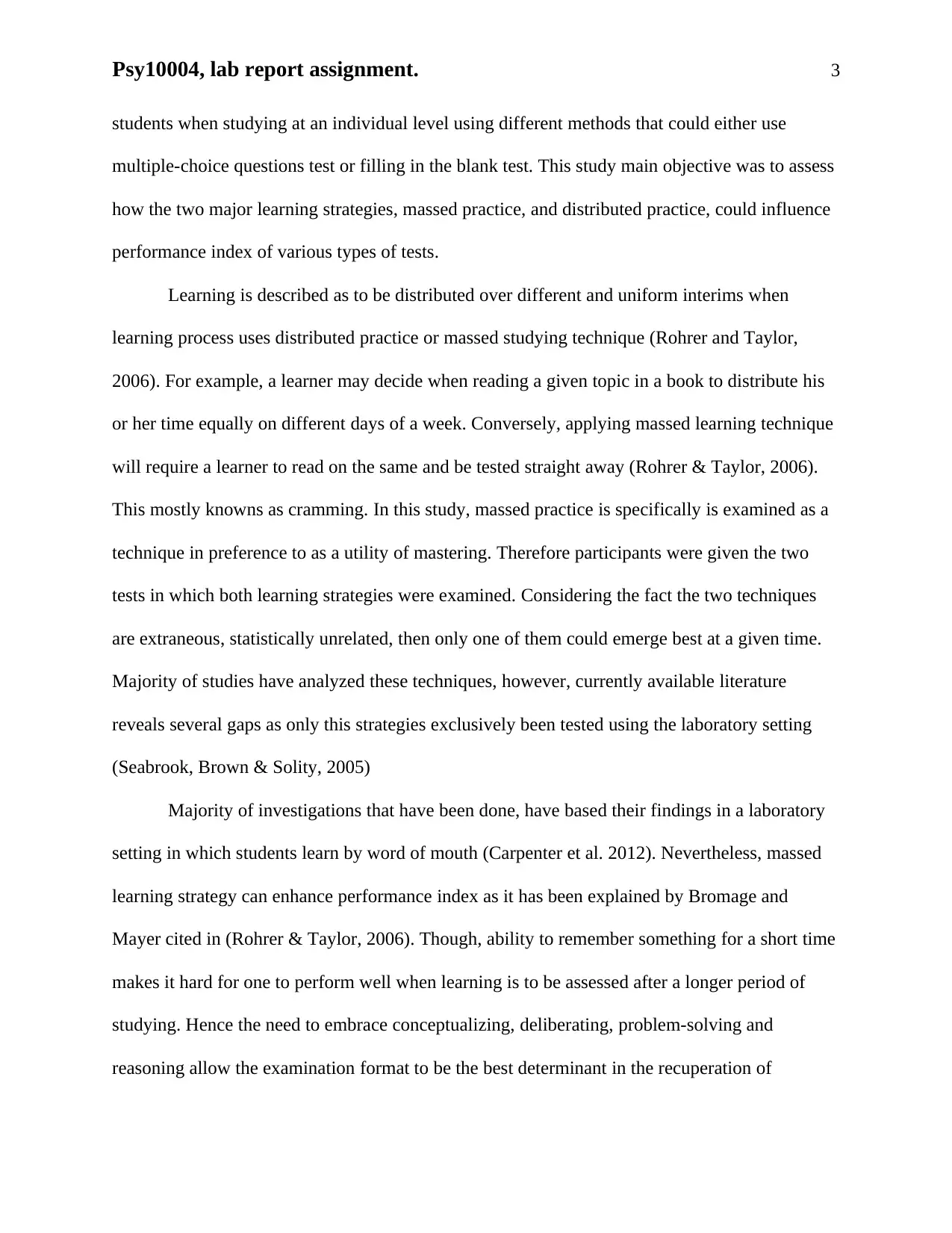
Psy10004, lab report assignment. 3
students when studying at an individual level using different methods that could either use
multiple-choice questions test or filling in the blank test. This study main objective was to assess
how the two major learning strategies, massed practice, and distributed practice, could influence
performance index of various types of tests.
Learning is described as to be distributed over different and uniform interims when
learning process uses distributed practice or massed studying technique (Rohrer and Taylor,
2006). For example, a learner may decide when reading a given topic in a book to distribute his
or her time equally on different days of a week. Conversely, applying massed learning technique
will require a learner to read on the same and be tested straight away (Rohrer & Taylor, 2006).
This mostly knowns as cramming. In this study, massed practice is specifically is examined as a
technique in preference to as a utility of mastering. Therefore participants were given the two
tests in which both learning strategies were examined. Considering the fact the two techniques
are extraneous, statistically unrelated, then only one of them could emerge best at a given time.
Majority of studies have analyzed these techniques, however, currently available literature
reveals several gaps as only this strategies exclusively been tested using the laboratory setting
(Seabrook, Brown & Solity, 2005)
Majority of investigations that have been done, have based their findings in a laboratory
setting in which students learn by word of mouth (Carpenter et al. 2012). Nevertheless, massed
learning strategy can enhance performance index as it has been explained by Bromage and
Mayer cited in (Rohrer & Taylor, 2006). Though, ability to remember something for a short time
makes it hard for one to perform well when learning is to be assessed after a longer period of
studying. Hence the need to embrace conceptualizing, deliberating, problem-solving and
reasoning allow the examination format to be the best determinant in the recuperation of
students when studying at an individual level using different methods that could either use
multiple-choice questions test or filling in the blank test. This study main objective was to assess
how the two major learning strategies, massed practice, and distributed practice, could influence
performance index of various types of tests.
Learning is described as to be distributed over different and uniform interims when
learning process uses distributed practice or massed studying technique (Rohrer and Taylor,
2006). For example, a learner may decide when reading a given topic in a book to distribute his
or her time equally on different days of a week. Conversely, applying massed learning technique
will require a learner to read on the same and be tested straight away (Rohrer & Taylor, 2006).
This mostly knowns as cramming. In this study, massed practice is specifically is examined as a
technique in preference to as a utility of mastering. Therefore participants were given the two
tests in which both learning strategies were examined. Considering the fact the two techniques
are extraneous, statistically unrelated, then only one of them could emerge best at a given time.
Majority of studies have analyzed these techniques, however, currently available literature
reveals several gaps as only this strategies exclusively been tested using the laboratory setting
(Seabrook, Brown & Solity, 2005)
Majority of investigations that have been done, have based their findings in a laboratory
setting in which students learn by word of mouth (Carpenter et al. 2012). Nevertheless, massed
learning strategy can enhance performance index as it has been explained by Bromage and
Mayer cited in (Rohrer & Taylor, 2006). Though, ability to remember something for a short time
makes it hard for one to perform well when learning is to be assessed after a longer period of
studying. Hence the need to embrace conceptualizing, deliberating, problem-solving and
reasoning allow the examination format to be the best determinant in the recuperation of
⊘ This is a preview!⊘
Do you want full access?
Subscribe today to unlock all pages.

Trusted by 1+ million students worldwide
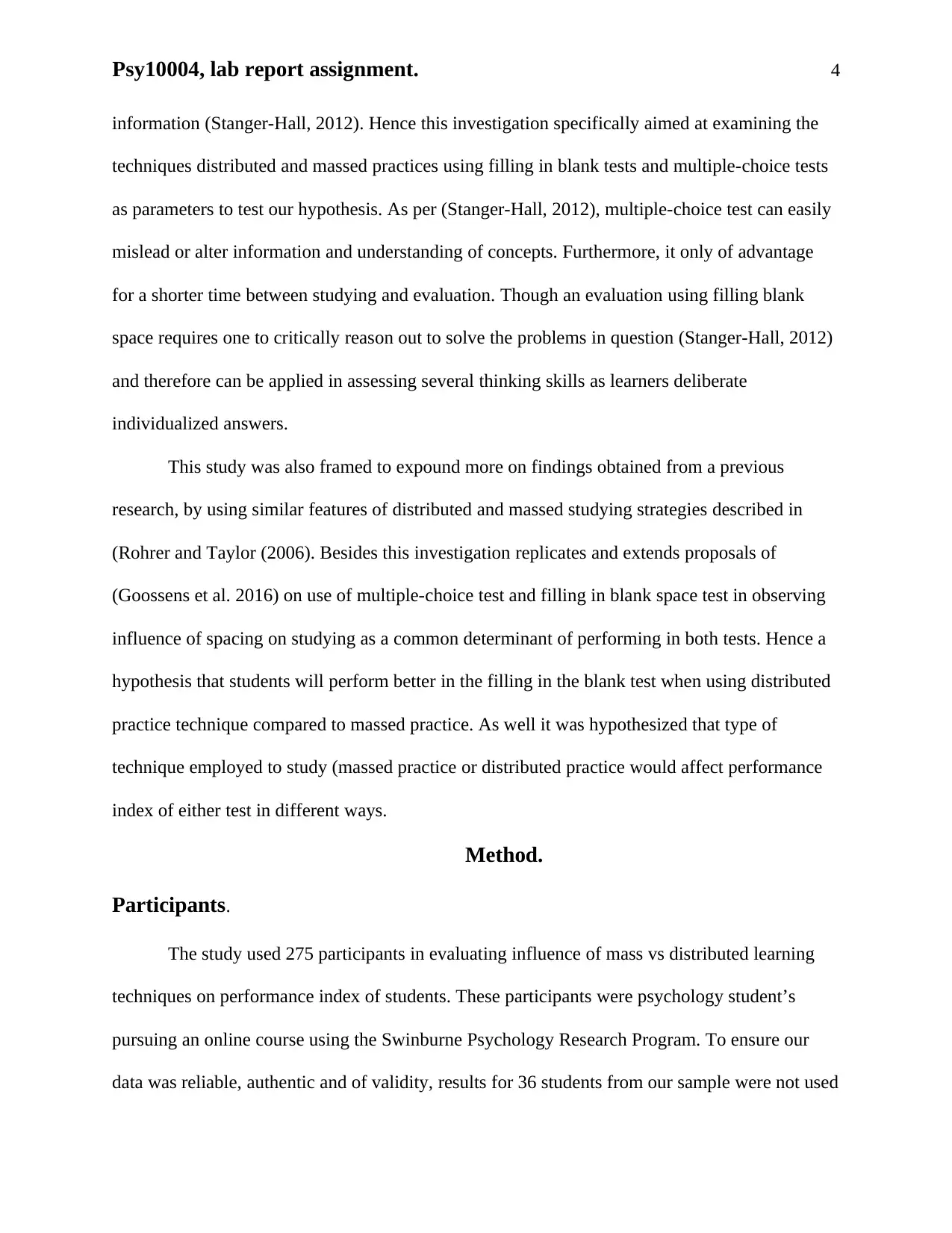
Psy10004, lab report assignment. 4
information (Stanger-Hall, 2012). Hence this investigation specifically aimed at examining the
techniques distributed and massed practices using filling in blank tests and multiple-choice tests
as parameters to test our hypothesis. As per (Stanger-Hall, 2012), multiple-choice test can easily
mislead or alter information and understanding of concepts. Furthermore, it only of advantage
for a shorter time between studying and evaluation. Though an evaluation using filling blank
space requires one to critically reason out to solve the problems in question (Stanger-Hall, 2012)
and therefore can be applied in assessing several thinking skills as learners deliberate
individualized answers.
This study was also framed to expound more on findings obtained from a previous
research, by using similar features of distributed and massed studying strategies described in
(Rohrer and Taylor (2006). Besides this investigation replicates and extends proposals of
(Goossens et al. 2016) on use of multiple-choice test and filling in blank space test in observing
influence of spacing on studying as a common determinant of performing in both tests. Hence a
hypothesis that students will perform better in the filling in the blank test when using distributed
practice technique compared to massed practice. As well it was hypothesized that type of
technique employed to study (massed practice or distributed practice would affect performance
index of either test in different ways.
Method.
Participants.
The study used 275 participants in evaluating influence of mass vs distributed learning
techniques on performance index of students. These participants were psychology student’s
pursuing an online course using the Swinburne Psychology Research Program. To ensure our
data was reliable, authentic and of validity, results for 36 students from our sample were not used
information (Stanger-Hall, 2012). Hence this investigation specifically aimed at examining the
techniques distributed and massed practices using filling in blank tests and multiple-choice tests
as parameters to test our hypothesis. As per (Stanger-Hall, 2012), multiple-choice test can easily
mislead or alter information and understanding of concepts. Furthermore, it only of advantage
for a shorter time between studying and evaluation. Though an evaluation using filling blank
space requires one to critically reason out to solve the problems in question (Stanger-Hall, 2012)
and therefore can be applied in assessing several thinking skills as learners deliberate
individualized answers.
This study was also framed to expound more on findings obtained from a previous
research, by using similar features of distributed and massed studying strategies described in
(Rohrer and Taylor (2006). Besides this investigation replicates and extends proposals of
(Goossens et al. 2016) on use of multiple-choice test and filling in blank space test in observing
influence of spacing on studying as a common determinant of performing in both tests. Hence a
hypothesis that students will perform better in the filling in the blank test when using distributed
practice technique compared to massed practice. As well it was hypothesized that type of
technique employed to study (massed practice or distributed practice would affect performance
index of either test in different ways.
Method.
Participants.
The study used 275 participants in evaluating influence of mass vs distributed learning
techniques on performance index of students. These participants were psychology student’s
pursuing an online course using the Swinburne Psychology Research Program. To ensure our
data was reliable, authentic and of validity, results for 36 students from our sample were not used
Paraphrase This Document
Need a fresh take? Get an instant paraphrase of this document with our AI Paraphraser
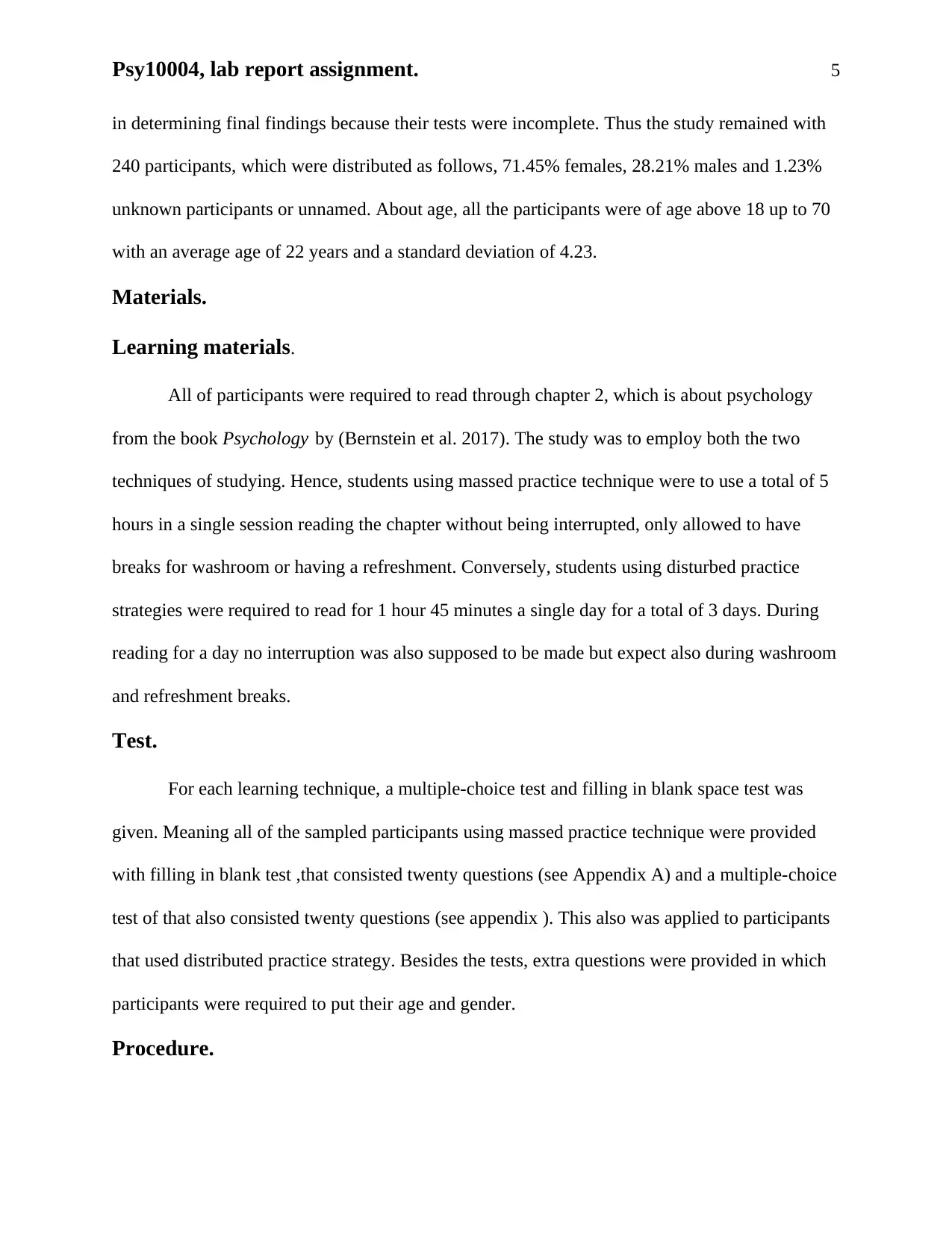
Psy10004, lab report assignment. 5
in determining final findings because their tests were incomplete. Thus the study remained with
240 participants, which were distributed as follows, 71.45% females, 28.21% males and 1.23%
unknown participants or unnamed. About age, all the participants were of age above 18 up to 70
with an average age of 22 years and a standard deviation of 4.23.
Materials.
Learning materials.
All of participants were required to read through chapter 2, which is about psychology
from the book Psychology by (Bernstein et al. 2017). The study was to employ both the two
techniques of studying. Hence, students using massed practice technique were to use a total of 5
hours in a single session reading the chapter without being interrupted, only allowed to have
breaks for washroom or having a refreshment. Conversely, students using disturbed practice
strategies were required to read for 1 hour 45 minutes a single day for a total of 3 days. During
reading for a day no interruption was also supposed to be made but expect also during washroom
and refreshment breaks.
Test.
For each learning technique, a multiple-choice test and filling in blank space test was
given. Meaning all of the sampled participants using massed practice technique were provided
with filling in blank test ,that consisted twenty questions (see Appendix A) and a multiple-choice
test of that also consisted twenty questions (see appendix ). This also was applied to participants
that used distributed practice strategy. Besides the tests, extra questions were provided in which
participants were required to put their age and gender.
Procedure.
in determining final findings because their tests were incomplete. Thus the study remained with
240 participants, which were distributed as follows, 71.45% females, 28.21% males and 1.23%
unknown participants or unnamed. About age, all the participants were of age above 18 up to 70
with an average age of 22 years and a standard deviation of 4.23.
Materials.
Learning materials.
All of participants were required to read through chapter 2, which is about psychology
from the book Psychology by (Bernstein et al. 2017). The study was to employ both the two
techniques of studying. Hence, students using massed practice technique were to use a total of 5
hours in a single session reading the chapter without being interrupted, only allowed to have
breaks for washroom or having a refreshment. Conversely, students using disturbed practice
strategies were required to read for 1 hour 45 minutes a single day for a total of 3 days. During
reading for a day no interruption was also supposed to be made but expect also during washroom
and refreshment breaks.
Test.
For each learning technique, a multiple-choice test and filling in blank space test was
given. Meaning all of the sampled participants using massed practice technique were provided
with filling in blank test ,that consisted twenty questions (see Appendix A) and a multiple-choice
test of that also consisted twenty questions (see appendix ). This also was applied to participants
that used distributed practice strategy. Besides the tests, extra questions were provided in which
participants were required to put their age and gender.
Procedure.
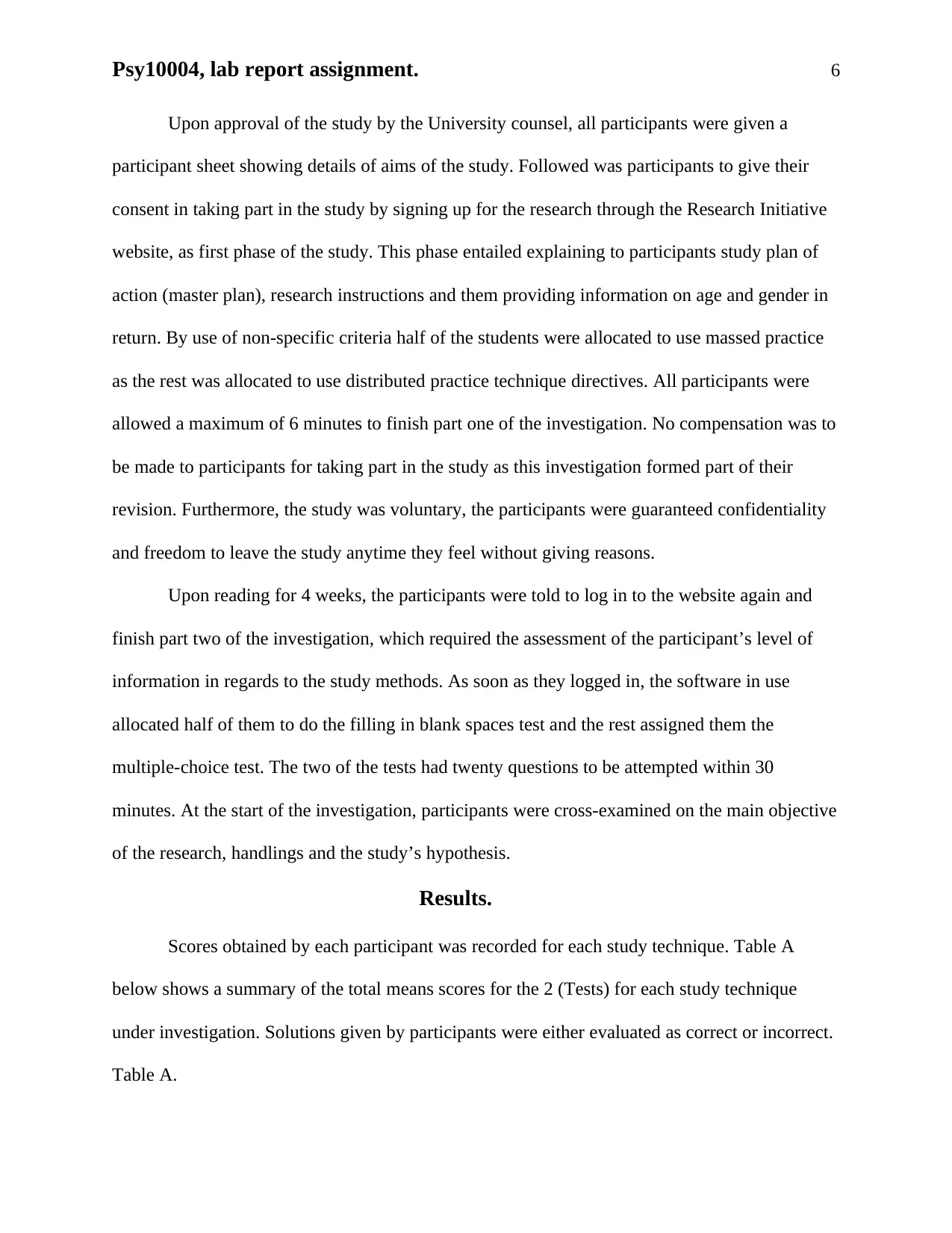
Psy10004, lab report assignment. 6
Upon approval of the study by the University counsel, all participants were given a
participant sheet showing details of aims of the study. Followed was participants to give their
consent in taking part in the study by signing up for the research through the Research Initiative
website, as first phase of the study. This phase entailed explaining to participants study plan of
action (master plan), research instructions and them providing information on age and gender in
return. By use of non-specific criteria half of the students were allocated to use massed practice
as the rest was allocated to use distributed practice technique directives. All participants were
allowed a maximum of 6 minutes to finish part one of the investigation. No compensation was to
be made to participants for taking part in the study as this investigation formed part of their
revision. Furthermore, the study was voluntary, the participants were guaranteed confidentiality
and freedom to leave the study anytime they feel without giving reasons.
Upon reading for 4 weeks, the participants were told to log in to the website again and
finish part two of the investigation, which required the assessment of the participant’s level of
information in regards to the study methods. As soon as they logged in, the software in use
allocated half of them to do the filling in blank spaces test and the rest assigned them the
multiple-choice test. The two of the tests had twenty questions to be attempted within 30
minutes. At the start of the investigation, participants were cross-examined on the main objective
of the research, handlings and the study’s hypothesis.
Results.
Scores obtained by each participant was recorded for each study technique. Table A
below shows a summary of the total means scores for the 2 (Tests) for each study technique
under investigation. Solutions given by participants were either evaluated as correct or incorrect.
Table A.
Upon approval of the study by the University counsel, all participants were given a
participant sheet showing details of aims of the study. Followed was participants to give their
consent in taking part in the study by signing up for the research through the Research Initiative
website, as first phase of the study. This phase entailed explaining to participants study plan of
action (master plan), research instructions and them providing information on age and gender in
return. By use of non-specific criteria half of the students were allocated to use massed practice
as the rest was allocated to use distributed practice technique directives. All participants were
allowed a maximum of 6 minutes to finish part one of the investigation. No compensation was to
be made to participants for taking part in the study as this investigation formed part of their
revision. Furthermore, the study was voluntary, the participants were guaranteed confidentiality
and freedom to leave the study anytime they feel without giving reasons.
Upon reading for 4 weeks, the participants were told to log in to the website again and
finish part two of the investigation, which required the assessment of the participant’s level of
information in regards to the study methods. As soon as they logged in, the software in use
allocated half of them to do the filling in blank spaces test and the rest assigned them the
multiple-choice test. The two of the tests had twenty questions to be attempted within 30
minutes. At the start of the investigation, participants were cross-examined on the main objective
of the research, handlings and the study’s hypothesis.
Results.
Scores obtained by each participant was recorded for each study technique. Table A
below shows a summary of the total means scores for the 2 (Tests) for each study technique
under investigation. Solutions given by participants were either evaluated as correct or incorrect.
Table A.
⊘ This is a preview!⊘
Do you want full access?
Subscribe today to unlock all pages.

Trusted by 1+ million students worldwide
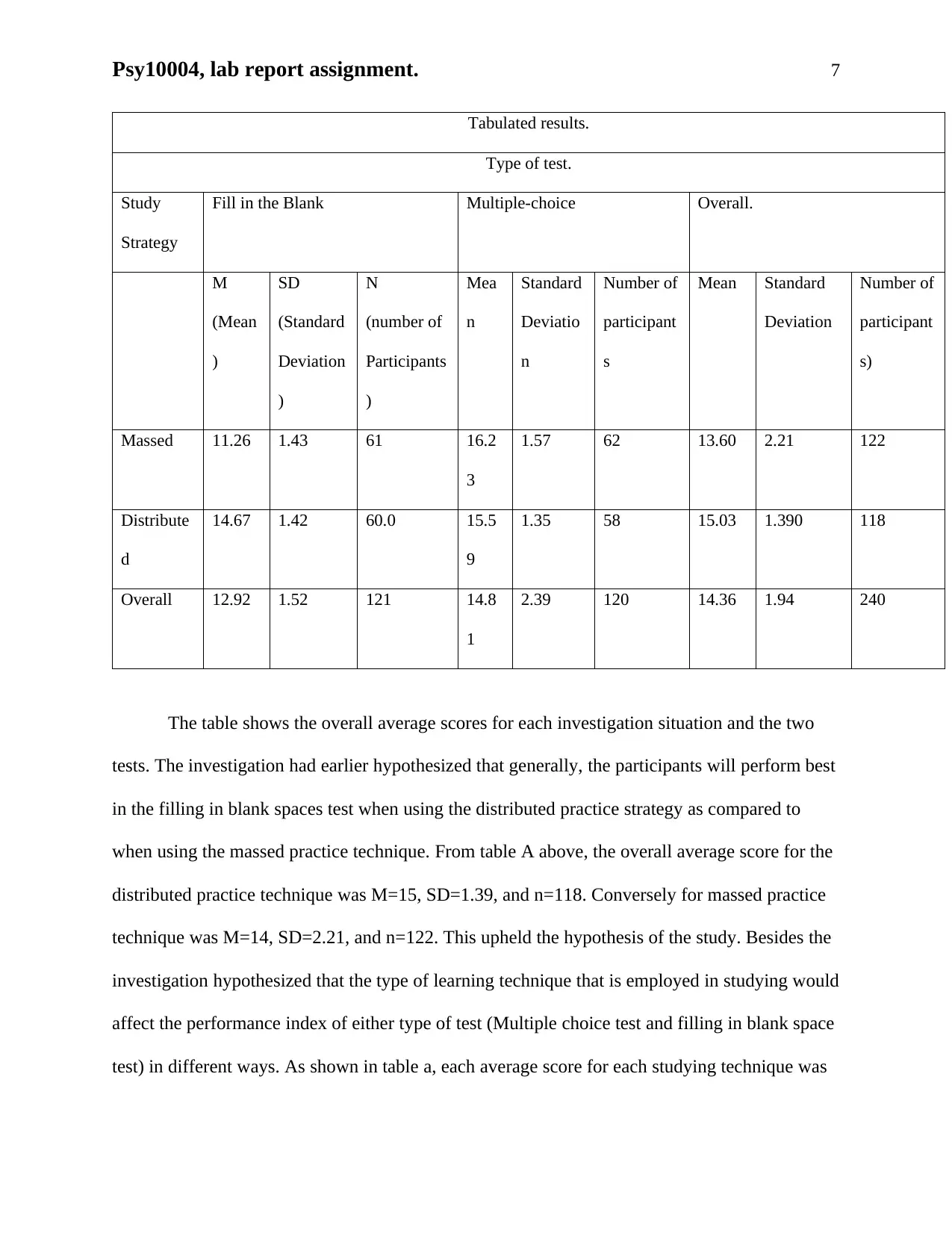
Psy10004, lab report assignment. 7
Tabulated results.
Type of test.
Study
Strategy
Fill in the Blank Multiple-choice Overall.
M
(Mean
)
SD
(Standard
Deviation
)
N
(number of
Participants
)
Mea
n
Standard
Deviatio
n
Number of
participant
s
Mean Standard
Deviation
Number of
participant
s)
Massed 11.26 1.43 61 16.2
3
1.57 62 13.60 2.21 122
Distribute
d
14.67 1.42 60.0 15.5
9
1.35 58 15.03 1.390 118
Overall 12.92 1.52 121 14.8
1
2.39 120 14.36 1.94 240
The table shows the overall average scores for each investigation situation and the two
tests. The investigation had earlier hypothesized that generally, the participants will perform best
in the filling in blank spaces test when using the distributed practice strategy as compared to
when using the massed practice technique. From table A above, the overall average score for the
distributed practice technique was M=15, SD=1.39, and n=118. Conversely for massed practice
technique was M=14, SD=2.21, and n=122. This upheld the hypothesis of the study. Besides the
investigation hypothesized that the type of learning technique that is employed in studying would
affect the performance index of either type of test (Multiple choice test and filling in blank space
test) in different ways. As shown in table a, each average score for each studying technique was
Tabulated results.
Type of test.
Study
Strategy
Fill in the Blank Multiple-choice Overall.
M
(Mean
)
SD
(Standard
Deviation
)
N
(number of
Participants
)
Mea
n
Standard
Deviatio
n
Number of
participant
s
Mean Standard
Deviation
Number of
participant
s)
Massed 11.26 1.43 61 16.2
3
1.57 62 13.60 2.21 122
Distribute
d
14.67 1.42 60.0 15.5
9
1.35 58 15.03 1.390 118
Overall 12.92 1.52 121 14.8
1
2.39 120 14.36 1.94 240
The table shows the overall average scores for each investigation situation and the two
tests. The investigation had earlier hypothesized that generally, the participants will perform best
in the filling in blank spaces test when using the distributed practice strategy as compared to
when using the massed practice technique. From table A above, the overall average score for the
distributed practice technique was M=15, SD=1.39, and n=118. Conversely for massed practice
technique was M=14, SD=2.21, and n=122. This upheld the hypothesis of the study. Besides the
investigation hypothesized that the type of learning technique that is employed in studying would
affect the performance index of either type of test (Multiple choice test and filling in blank space
test) in different ways. As shown in table a, each average score for each studying technique was
Paraphrase This Document
Need a fresh take? Get an instant paraphrase of this document with our AI Paraphraser
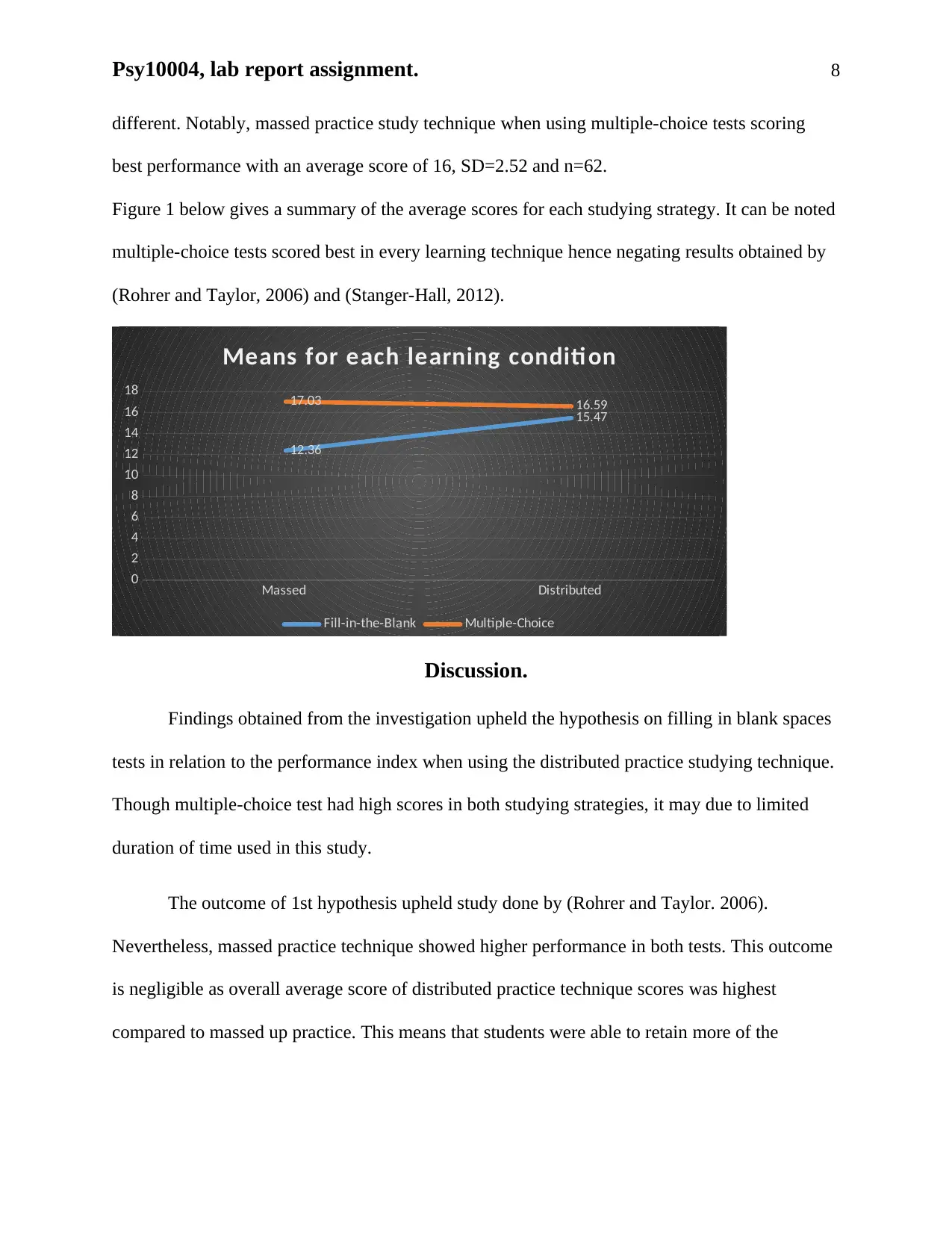
Psy10004, lab report assignment. 8
different. Notably, massed practice study technique when using multiple-choice tests scoring
best performance with an average score of 16, SD=2.52 and n=62.
Figure 1 below gives a summary of the average scores for each studying strategy. It can be noted
multiple-choice tests scored best in every learning technique hence negating results obtained by
(Rohrer and Taylor, 2006) and (Stanger-Hall, 2012).
Massed Distributed
0
2
4
6
8
10
12
14
16
18
12.36
15.47
17.03 16.59
Means for each learning conditi on
Fill-in-the-Blank Multiple-Choice
Discussion.
Findings obtained from the investigation upheld the hypothesis on filling in blank spaces
tests in relation to the performance index when using the distributed practice studying technique.
Though multiple-choice test had high scores in both studying strategies, it may due to limited
duration of time used in this study.
The outcome of 1st hypothesis upheld study done by (Rohrer and Taylor. 2006).
Nevertheless, massed practice technique showed higher performance in both tests. This outcome
is negligible as overall average score of distributed practice technique scores was highest
compared to massed up practice. This means that students were able to retain more of the
different. Notably, massed practice study technique when using multiple-choice tests scoring
best performance with an average score of 16, SD=2.52 and n=62.
Figure 1 below gives a summary of the average scores for each studying strategy. It can be noted
multiple-choice tests scored best in every learning technique hence negating results obtained by
(Rohrer and Taylor, 2006) and (Stanger-Hall, 2012).
Massed Distributed
0
2
4
6
8
10
12
14
16
18
12.36
15.47
17.03 16.59
Means for each learning conditi on
Fill-in-the-Blank Multiple-Choice
Discussion.
Findings obtained from the investigation upheld the hypothesis on filling in blank spaces
tests in relation to the performance index when using the distributed practice studying technique.
Though multiple-choice test had high scores in both studying strategies, it may due to limited
duration of time used in this study.
The outcome of 1st hypothesis upheld study done by (Rohrer and Taylor. 2006).
Nevertheless, massed practice technique showed higher performance in both tests. This outcome
is negligible as overall average score of distributed practice technique scores was highest
compared to massed up practice. This means that students were able to retain more of the
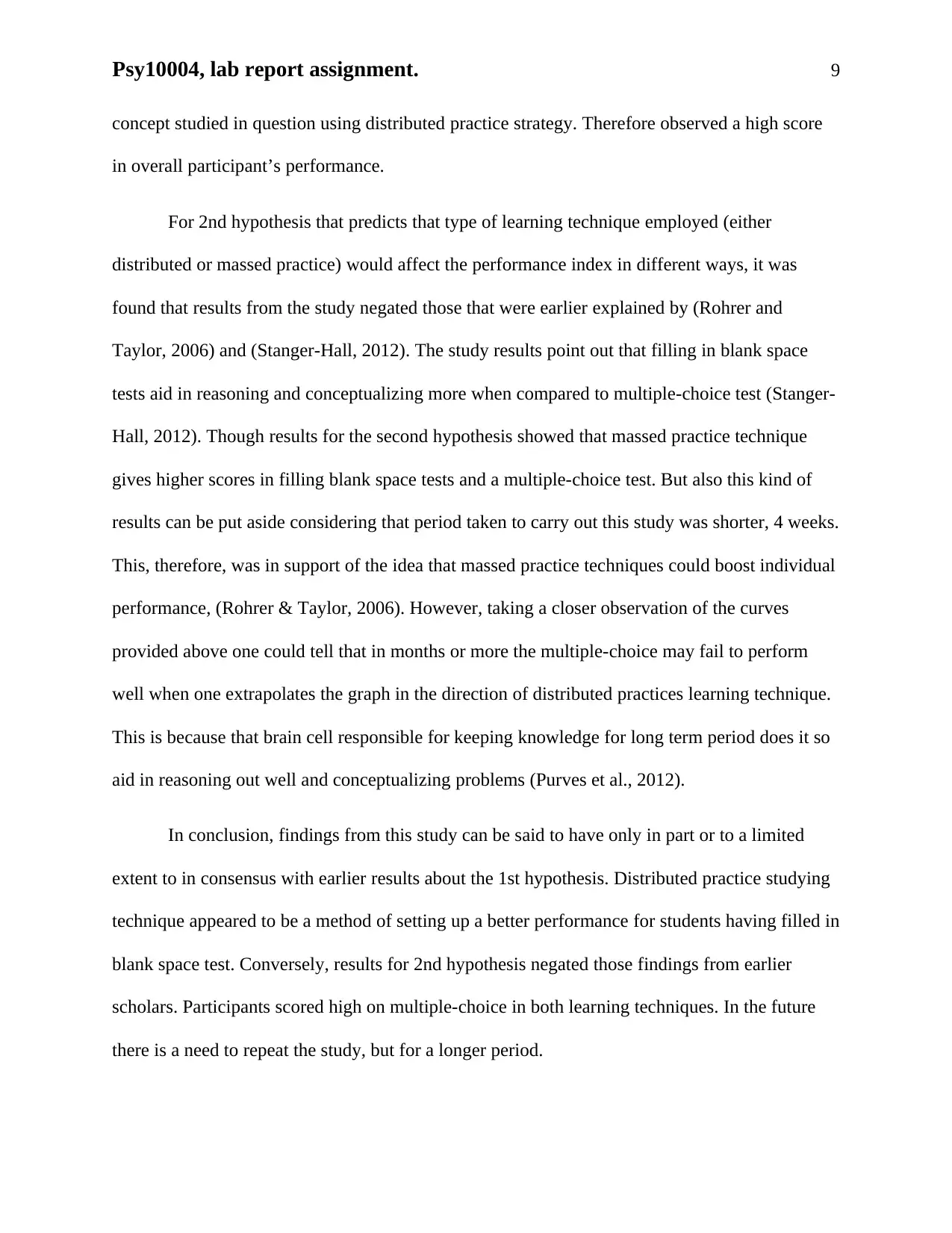
Psy10004, lab report assignment. 9
concept studied in question using distributed practice strategy. Therefore observed a high score
in overall participant’s performance.
For 2nd hypothesis that predicts that type of learning technique employed (either
distributed or massed practice) would affect the performance index in different ways, it was
found that results from the study negated those that were earlier explained by (Rohrer and
Taylor, 2006) and (Stanger-Hall, 2012). The study results point out that filling in blank space
tests aid in reasoning and conceptualizing more when compared to multiple-choice test (Stanger-
Hall, 2012). Though results for the second hypothesis showed that massed practice technique
gives higher scores in filling blank space tests and a multiple-choice test. But also this kind of
results can be put aside considering that period taken to carry out this study was shorter, 4 weeks.
This, therefore, was in support of the idea that massed practice techniques could boost individual
performance, (Rohrer & Taylor, 2006). However, taking a closer observation of the curves
provided above one could tell that in months or more the multiple-choice may fail to perform
well when one extrapolates the graph in the direction of distributed practices learning technique.
This is because that brain cell responsible for keeping knowledge for long term period does it so
aid in reasoning out well and conceptualizing problems (Purves et al., 2012).
In conclusion, findings from this study can be said to have only in part or to a limited
extent to in consensus with earlier results about the 1st hypothesis. Distributed practice studying
technique appeared to be a method of setting up a better performance for students having filled in
blank space test. Conversely, results for 2nd hypothesis negated those findings from earlier
scholars. Participants scored high on multiple-choice in both learning techniques. In the future
there is a need to repeat the study, but for a longer period.
concept studied in question using distributed practice strategy. Therefore observed a high score
in overall participant’s performance.
For 2nd hypothesis that predicts that type of learning technique employed (either
distributed or massed practice) would affect the performance index in different ways, it was
found that results from the study negated those that were earlier explained by (Rohrer and
Taylor, 2006) and (Stanger-Hall, 2012). The study results point out that filling in blank space
tests aid in reasoning and conceptualizing more when compared to multiple-choice test (Stanger-
Hall, 2012). Though results for the second hypothesis showed that massed practice technique
gives higher scores in filling blank space tests and a multiple-choice test. But also this kind of
results can be put aside considering that period taken to carry out this study was shorter, 4 weeks.
This, therefore, was in support of the idea that massed practice techniques could boost individual
performance, (Rohrer & Taylor, 2006). However, taking a closer observation of the curves
provided above one could tell that in months or more the multiple-choice may fail to perform
well when one extrapolates the graph in the direction of distributed practices learning technique.
This is because that brain cell responsible for keeping knowledge for long term period does it so
aid in reasoning out well and conceptualizing problems (Purves et al., 2012).
In conclusion, findings from this study can be said to have only in part or to a limited
extent to in consensus with earlier results about the 1st hypothesis. Distributed practice studying
technique appeared to be a method of setting up a better performance for students having filled in
blank space test. Conversely, results for 2nd hypothesis negated those findings from earlier
scholars. Participants scored high on multiple-choice in both learning techniques. In the future
there is a need to repeat the study, but for a longer period.
⊘ This is a preview!⊘
Do you want full access?
Subscribe today to unlock all pages.

Trusted by 1+ million students worldwide
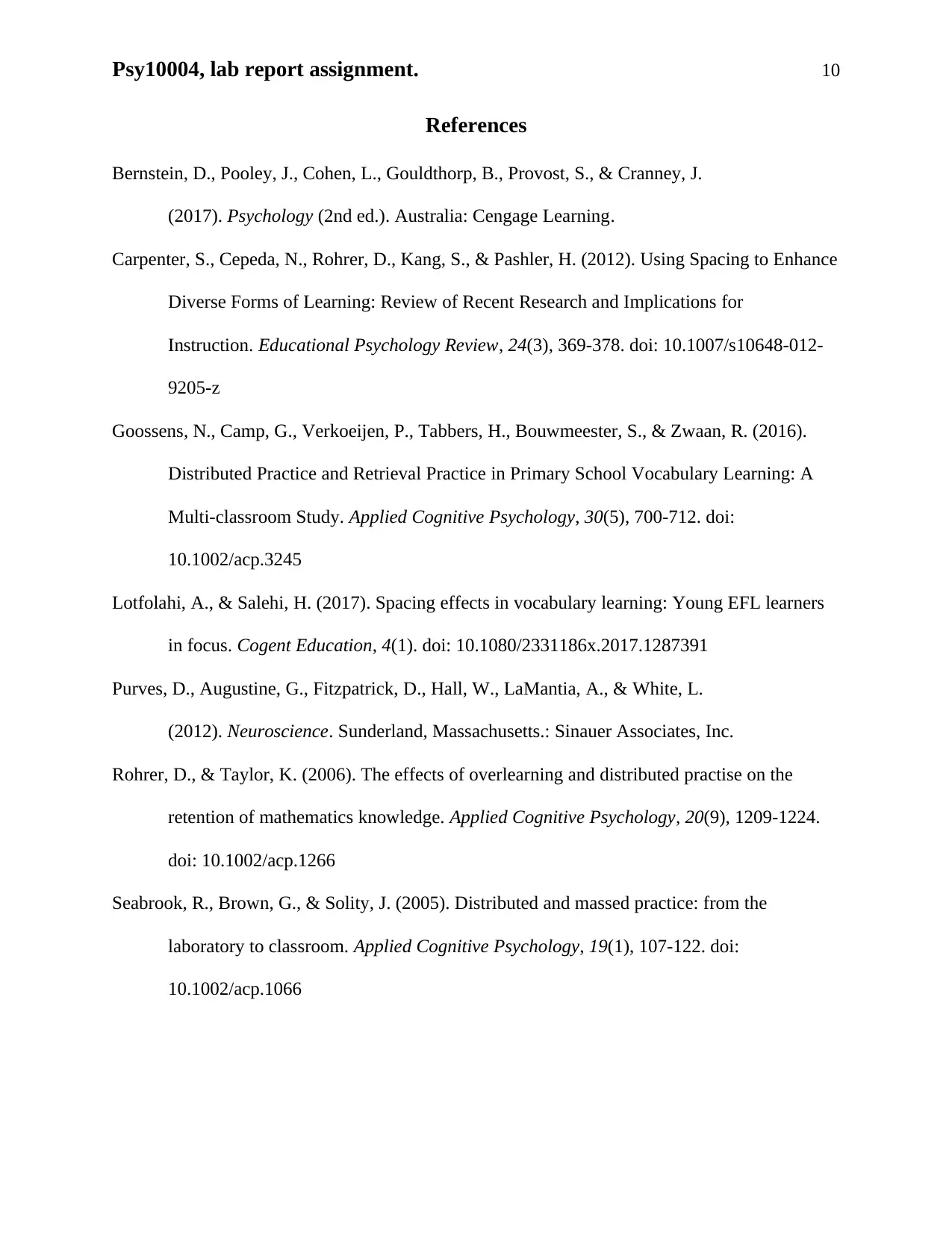
Psy10004, lab report assignment. 10
References
Bernstein, D., Pooley, J., Cohen, L., Gouldthorp, B., Provost, S., & Cranney, J.
(2017). Psychology (2nd ed.). Australia: Cengage Learning.
Carpenter, S., Cepeda, N., Rohrer, D., Kang, S., & Pashler, H. (2012). Using Spacing to Enhance
Diverse Forms of Learning: Review of Recent Research and Implications for
Instruction. Educational Psychology Review, 24(3), 369-378. doi: 10.1007/s10648-012-
9205-z
Goossens, N., Camp, G., Verkoeijen, P., Tabbers, H., Bouwmeester, S., & Zwaan, R. (2016).
Distributed Practice and Retrieval Practice in Primary School Vocabulary Learning: A
Multi-classroom Study. Applied Cognitive Psychology, 30(5), 700-712. doi:
10.1002/acp.3245
Lotfolahi, A., & Salehi, H. (2017). Spacing effects in vocabulary learning: Young EFL learners
in focus. Cogent Education, 4(1). doi: 10.1080/2331186x.2017.1287391
Purves, D., Augustine, G., Fitzpatrick, D., Hall, W., LaMantia, A., & White, L.
(2012). Neuroscience. Sunderland, Massachusetts.: Sinauer Associates, Inc.
Rohrer, D., & Taylor, K. (2006). The effects of overlearning and distributed practise on the
retention of mathematics knowledge. Applied Cognitive Psychology, 20(9), 1209-1224.
doi: 10.1002/acp.1266
Seabrook, R., Brown, G., & Solity, J. (2005). Distributed and massed practice: from the
laboratory to classroom. Applied Cognitive Psychology, 19(1), 107-122. doi:
10.1002/acp.1066
References
Bernstein, D., Pooley, J., Cohen, L., Gouldthorp, B., Provost, S., & Cranney, J.
(2017). Psychology (2nd ed.). Australia: Cengage Learning.
Carpenter, S., Cepeda, N., Rohrer, D., Kang, S., & Pashler, H. (2012). Using Spacing to Enhance
Diverse Forms of Learning: Review of Recent Research and Implications for
Instruction. Educational Psychology Review, 24(3), 369-378. doi: 10.1007/s10648-012-
9205-z
Goossens, N., Camp, G., Verkoeijen, P., Tabbers, H., Bouwmeester, S., & Zwaan, R. (2016).
Distributed Practice and Retrieval Practice in Primary School Vocabulary Learning: A
Multi-classroom Study. Applied Cognitive Psychology, 30(5), 700-712. doi:
10.1002/acp.3245
Lotfolahi, A., & Salehi, H. (2017). Spacing effects in vocabulary learning: Young EFL learners
in focus. Cogent Education, 4(1). doi: 10.1080/2331186x.2017.1287391
Purves, D., Augustine, G., Fitzpatrick, D., Hall, W., LaMantia, A., & White, L.
(2012). Neuroscience. Sunderland, Massachusetts.: Sinauer Associates, Inc.
Rohrer, D., & Taylor, K. (2006). The effects of overlearning and distributed practise on the
retention of mathematics knowledge. Applied Cognitive Psychology, 20(9), 1209-1224.
doi: 10.1002/acp.1266
Seabrook, R., Brown, G., & Solity, J. (2005). Distributed and massed practice: from the
laboratory to classroom. Applied Cognitive Psychology, 19(1), 107-122. doi:
10.1002/acp.1066
Paraphrase This Document
Need a fresh take? Get an instant paraphrase of this document with our AI Paraphraser
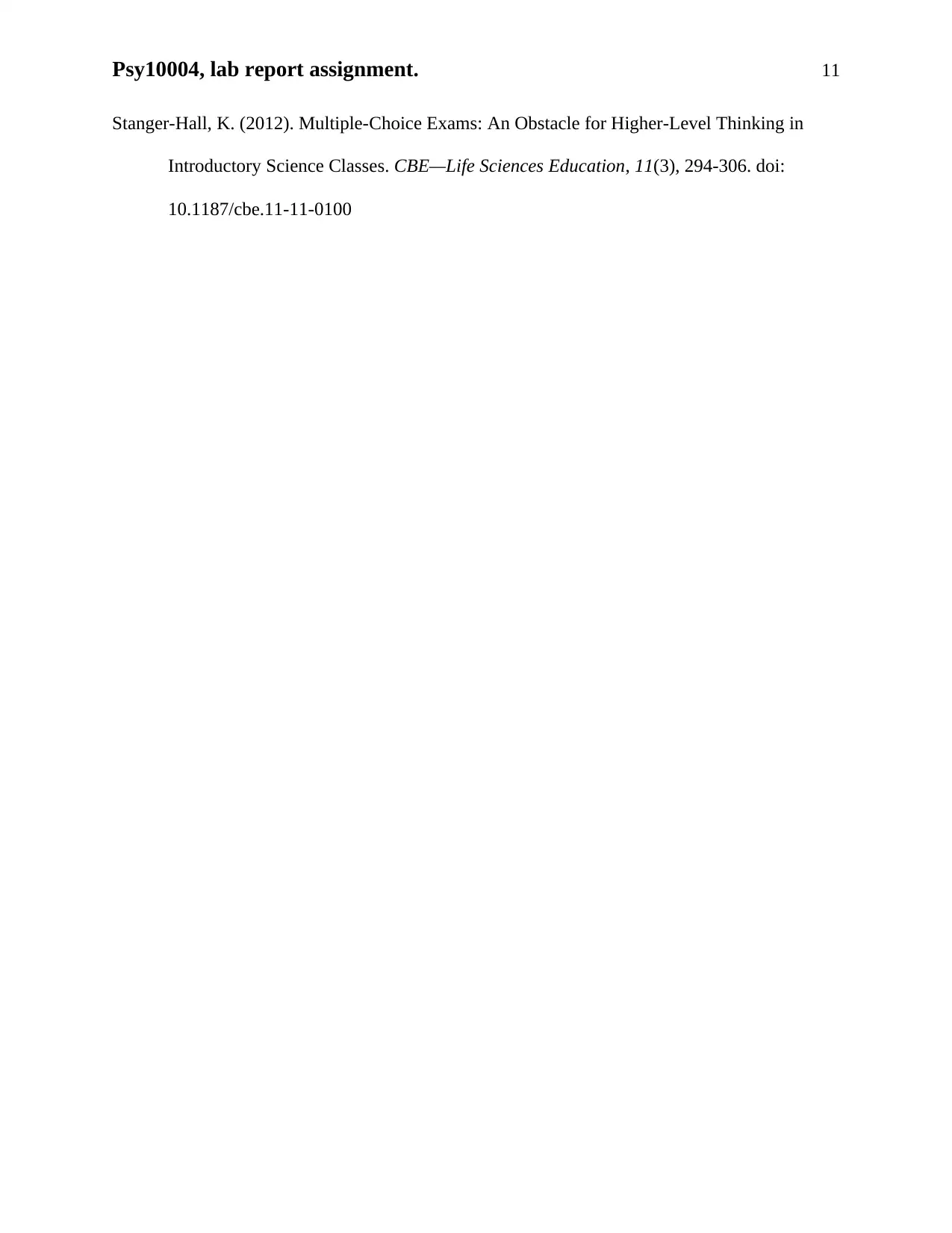
Psy10004, lab report assignment. 11
Stanger-Hall, K. (2012). Multiple-Choice Exams: An Obstacle for Higher-Level Thinking in
Introductory Science Classes. CBE—Life Sciences Education, 11(3), 294-306. doi:
10.1187/cbe.11-11-0100
Stanger-Hall, K. (2012). Multiple-Choice Exams: An Obstacle for Higher-Level Thinking in
Introductory Science Classes. CBE—Life Sciences Education, 11(3), 294-306. doi:
10.1187/cbe.11-11-0100
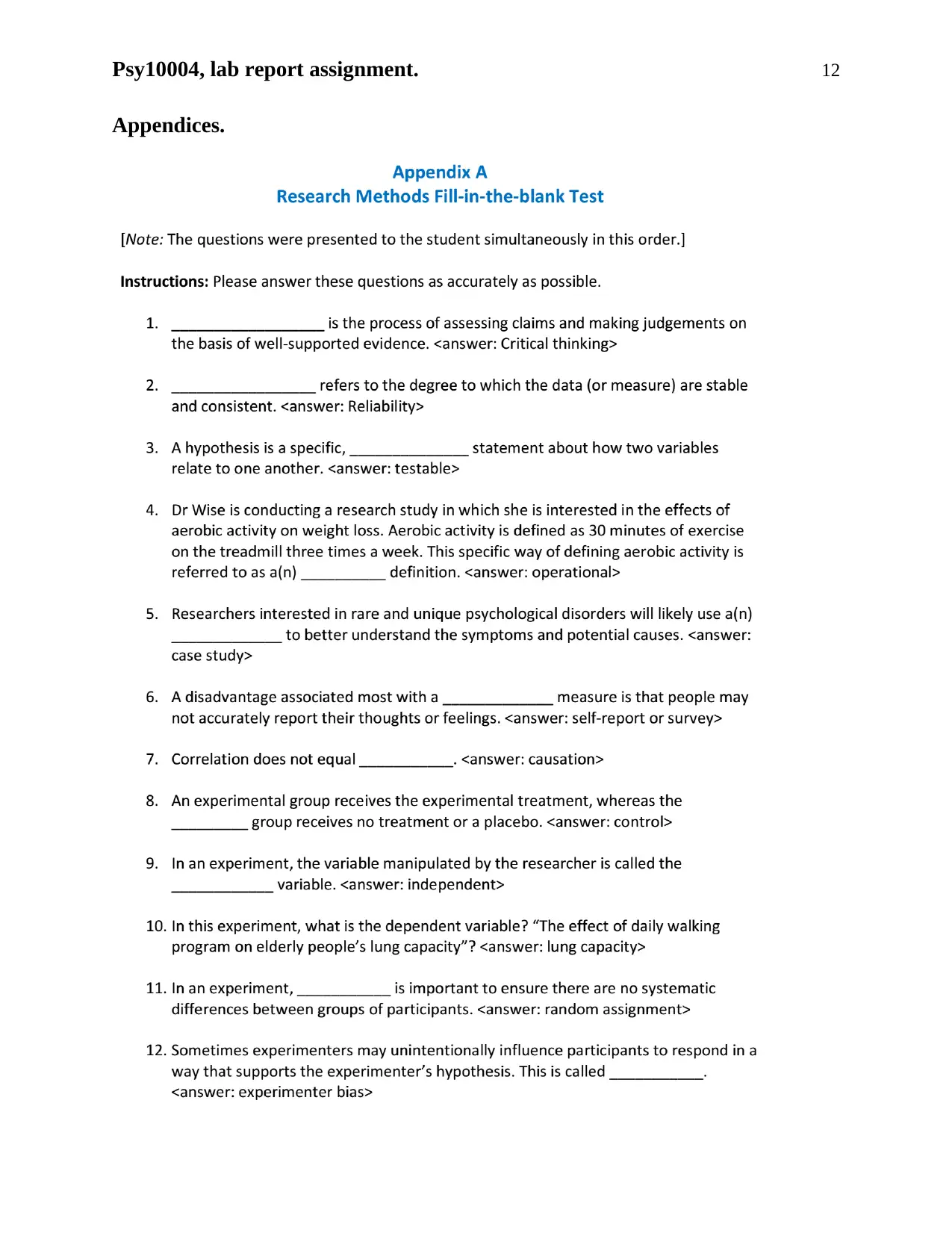
Psy10004, lab report assignment. 12
Appendices.
Appendices.
⊘ This is a preview!⊘
Do you want full access?
Subscribe today to unlock all pages.

Trusted by 1+ million students worldwide
1 out of 13
Related Documents
Your All-in-One AI-Powered Toolkit for Academic Success.
+13062052269
info@desklib.com
Available 24*7 on WhatsApp / Email
![[object Object]](/_next/static/media/star-bottom.7253800d.svg)
Unlock your academic potential
Copyright © 2020–2025 A2Z Services. All Rights Reserved. Developed and managed by ZUCOL.





